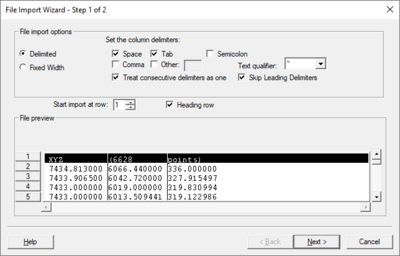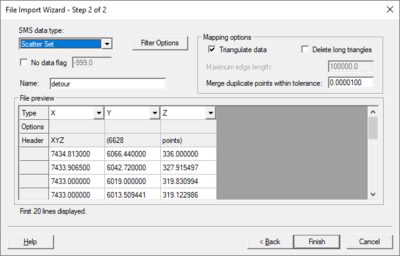SMS:File Import Wizard: Difference between revisions
No edit summary |
|||
| Line 7: | Line 7: | ||
== Step 1 – Delimiting Columns == | == Step 1 – Delimiting Columns == | ||
The first step in the wizard allows users to delimit the data into columns. The following options exist to delimit the data: | The first step in the wizard allows users to delimit the data into columns. The following options exist to delimit the data: | ||
* '''Delimited''' – For the ''Delimited'' option, typical delimiters are included as well as an option for users to specify a delimiter. | |||
* '''Fixed Width''' – Columns can be specified with a fixed width by clicking on the ruler bar or the window with the data. Break lines can be dragged, and they can be deleted by double-clicking on the break line or dragging them off the screen. | |||
The user can specify the starting row the data will be imported at. If your data has a row of headings, you can indicate such and SMS will use the headings in the next step to determine what kind of data each column represents. | The user can specify the starting row the data will be imported at. If your data has a row of headings, you can indicate such and SMS will use the headings in the next step to determine what kind of data each column represents. | ||
Revision as of 18:57, 16 December 2013
SMS can import many files generated by other software in their native format. Refer to Importing Non-native SMS Files for a list. For files that are not included in the list, SMS provides the Text Import Wizard.
The Text Import Wizard enables users to import many different types of data into SMS. The Text Import Wizard is initialized by selecting a *.txt file in the Open command from the File menu. The wizard has two steps:
Step 1 – Delimiting Columns
The first step in the wizard allows users to delimit the data into columns. The following options exist to delimit the data:
- Delimited – For the Delimited option, typical delimiters are included as well as an option for users to specify a delimiter.
- Fixed Width – Columns can be specified with a fixed width by clicking on the ruler bar or the window with the data. Break lines can be dragged, and they can be deleted by double-clicking on the break line or dragging them off the screen.
The user can specify the starting row the data will be imported at. If your data has a row of headings, you can indicate such and SMS will use the headings in the next step to determine what kind of data each column represents.
Step 2 – Assigning Column Types
The first 20 lines of the file are displayed in a spreadsheet according to the file outline specified in step 1. This step lets you pick what kind of data you are importing (see Supported File Formats). A "no data flag" can be specified for the file. This is a number that, when encountered in the file, tells SMS to mark the value as "NULL" or "no data". For example, a water surface elevation dataset would assign a no data flag to dry nodes.
The data in the columns are identified by selecting the type in the combo box at the top of each column in the spreadsheet. If a row of headings exists, SMS will automatically select the proper type if it recognizes the heading. Otherwise they are Not Mapped by default. The available column types changes depending on the SMS data type selected. Certain column types must be mapped for each file format before the user can progress to the next step in the wizard. The name of each column is changed by editing the Header cell.
Mapping Options
When reading in a scatter set or mesh data, the following mapping options are available:
- Triangulate data – Triangulates the scatter vertices / mesh nodes
- Merge duplicate – Merges duplicate scatter vertices / mesh nodes based on the specified tolerance
- Delete long triangles – Deletes scatter triangles with an edge length longer than the specified edge length
- Append mesh – Appends the mesh nodes to the existing mesh
Filter Options
When importing a Scatter Set, pressing the Filter Options button will open the File Import Filter Options dialog. The filter options are useful when reading scatter sets that are too large for SMS to successfully read in. Once the scatter set has been read into SMS, the more sophisticated normals filtering algorithm can be used.
Additional Options
After the data have been imported, the coordinate transformation tools can be used to transform and translate the data.
Related Topics
SMS – Surface-water Modeling System | ||
|---|---|---|
| Modules: | 1D Grid • Cartesian Grid • Curvilinear Grid • GIS • Map • Mesh • Particle • Quadtree • Raster • Scatter • UGrid |  |
| General Models: | 3D Structure • FVCOM • Generic • PTM | |
| Coastal Models: | ADCIRC • BOUSS-2D • CGWAVE • CMS-Flow • CMS-Wave • GenCade • STWAVE • WAM | |
| Riverine/Estuarine Models: | AdH • HEC-RAS • HYDRO AS-2D • RMA2 • RMA4 • SRH-2D • TUFLOW • TUFLOW FV | |
| Aquaveo • SMS Tutorials • SMS Workflows | ||

